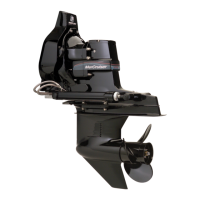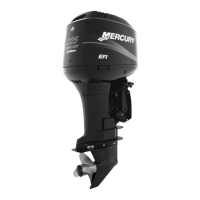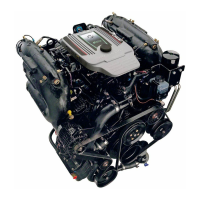Battery Storage
Whenever the battery will be stored for an extended period of time, be sure the cells are full of water and the battery is fully
charged and in good operating condition. It should be clean and free of leaks. Follow the battery manufacturer's instructions for
storage.
Recommissioning
NOTE: Discharge of propylene glycol antifreeze into the environment may be restricted by law. Contain and dispose of
propylene glycol antifreeze in accordance with federal, state, and local laws and guidelines.
1. On engines that were prepared for extended storage, refer to a Mercury Diesel authorized repair facility and have the
seawater pump impeller installed, if it was removed for storage.
2. On engines that were prepared for cold weather (freezing temperature), seasonal, or extended storage, drain the
propylene glycol antifreeze into a suitable container. Refer to Flushing and Draining the Seawater System. Dispose of
the propylene glycol antifreeze in accordance with federal, state, and local laws and guidelines.
3. Ensure that all cooling system hoses are in good condition, connected properly, and clamped tightly. Verify that all drain
valves and drain plugs are installed and tight.
4. Inspect all drive belts.
5.
Perform all lubrication and maintenance specified for completion according to Annually in Maintenance Schedules,
except items that were performed at time of engine storage.
6. Fill the fuel tanks with fresh diesel fuel. Do not use old fuel. Check the general condition of the fuel lines and inspect the
connections for leaks.
7. Replace the water‑separating fuel filter or filters (some engines may have more than one).
!
CAUTION
Disconnecting or connecting the battery cables in the incorrect order can cause injury from electrical shock or can damage
the electrical system. Always disconnect the negative (‑) battery cable first and connect it last.
8. Install a fully charged battery. Clean the battery cable clamps and terminals. Reconnect the cables (see the CAUTION
listed above). Secure each cable clamp when connecting. Coat terminals with a battery terminal anti‑corrosion spray to
help retard corrosion.
9.
Perform all checks in the Starting Procedure column found in the Operation Chart. See the On the Water section.
NOTICE
Without sufficient cooling water, the engine, the water pump, and other components will overheat and suffer damage. Provide
a sufficient supply of water to the water inlets during operation.
10. Supply cooling water to the water inlet openings.
11. Start the engine and closely observe instrumentation. Ensure that all systems are functioning correctly.
12. Carefully inspect the engine for fuel, oil, fluid, water, and exhaust leaks.
13. Check the steering system, shift, and throttle control for proper operation.
Section 5 - Storage
Page 60 90-8M0133568 eng JUNE 2017
